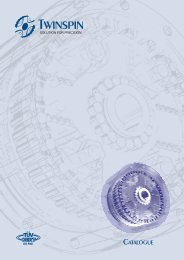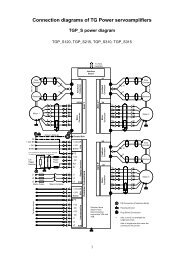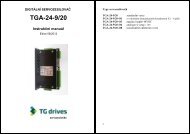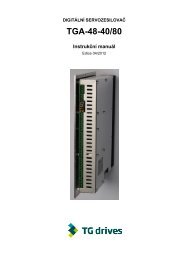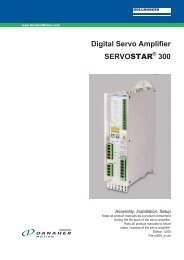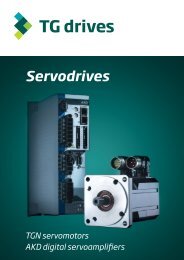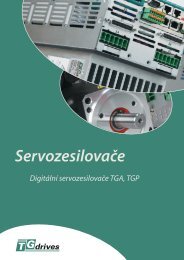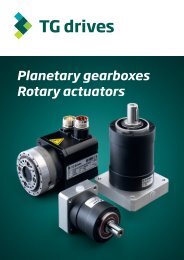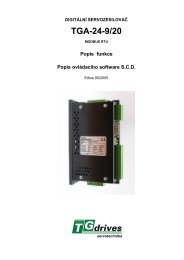- Page 1 and 2: HEAD OFFICE INMOTION TECHNOLOGIES A
- Page 3 and 4: Table of Contents Table of Contents
- Page 5 and 6: Related items .....................
- Page 7 and 8: Related items .....................
- Page 9: Creating/Editing Source Code ......
- Page 12 and 13: 12 System architecture register val
- Page 14 and 15: 14 B002 Timing and execution flow T
- Page 18 and 19: 18 Function Block Diagram Figure 5.
- Page 20 and 21: 20 Function Block Diagram Function
- Page 22 and 23: 22 Load a new firmware release SOFT
- Page 24 and 25: 24 User's Manual 5.1 Inmotion Techn
- Page 26 and 27: 26 Argument types executing results
- Page 28 and 29: 28 Mnemonic Operators PL2 NATIVE PO
- Page 30 and 31: 30 Compiler Symbols PL2 NATIVE POSI
- Page 32 and 33: 32 Compiler directives PL2 NATIVE P
- Page 34 and 35: 34 Compiler directives Warnings: No
- Page 36 and 37: 36 Spline function compilation dire
- Page 38 and 39: 38 Multiline Macro MACRO DEFINITION
- Page 41 and 42: PL2 Mnemonics GENERAL The general f
- Page 43 and 44: PL2 MNEMONICS Standard set Mnemonic
- Page 45 and 46: PL2 MNEMONICS TRACE RELATED MNEMONI
- Page 47 and 48: PL2 MNEMONICS Indexed Addressing Mn
- Page 49 and 50: PL2 MNEMONICS If r_length < r_Membe
- Page 51 and 52: PL2 MNEMONICS Text mode \000 Intern
- Page 53 and 54: Extended register groups INTRODUCTI
- Page 55 and 56: EXTENDED REGISTER GROUPS STACK HAND
- Page 57 and 58: EXTENDED REGISTER GROUPS RD1, Resol
- Page 59 and 60: EXTENDED REGISTER GROUPS RD1, Resol
- Page 61 and 62: EXTENDED REGISTER GROUPS RD1.FiltSp
- Page 63 and 64: EXTENDED REGISTER GROUPS RD2, Resol
- Page 65 and 66: EXTENDED REGISTER GROUPS RD2, Resol
- Page 67 and 68:
EXTENDED REGISTER GROUPS RD2.ChkLow
- Page 69 and 70:
EXTENDED REGISTER GROUPS Pos Inc Pr
- Page 71 and 72:
EXTENDED REGISTER GROUPS Pg.ASpeed
- Page 73 and 74:
EXTENDED REGISTER GROUPS MOTOR, MOT
- Page 75 and 76:
EXTENDED REGISTER GROUPS 2-Pole: 81
- Page 77 and 78:
EXTENDED REGISTER GROUPS Motor.Base
- Page 79 and 80:
EXTENDED REGISTER GROUPS REG, PID R
- Page 81 and 82:
EXTENDED REGISTER GROUPS GROUP MEMB
- Page 83 and 84:
EXTENDED REGISTER GROUPS Positive T
- Page 85 and 86:
EXTENDED REGISTER GROUPS Reg, PID r
- Page 87 and 88:
EXTENDED REGISTER GROUPS Gear.Incr
- Page 89 and 90:
EXTENDED REGISTER GROUPS GROUP MEMB
- Page 91 and 92:
EXTENDED REGISTER GROUPS Gear, Elec
- Page 93 and 94:
EXTENDED REGISTER GROUPS TMR, SYSTE
- Page 95 and 96:
EXTENDED REGISTER GROUPS Tmr, Syste
- Page 97 and 98:
EXTENDED REGISTER GROUPS RELATED IT
- Page 99 and 100:
EXTENDED REGISTER GROUPS SysIo.ADC1
- Page 101 and 102:
EXTENDED REGISTER GROUPS Bit10 (102
- Page 103 and 104:
EXTENDED REGISTER GROUPS INT, INTER
- Page 105 and 106:
EXTENDED REGISTER GROUPS Bit2 (4) =
- Page 107 and 108:
EXTENDED REGISTER GROUPS Int, Inter
- Page 109 and 110:
EXTENDED REGISTER GROUPS IN, DIGITA
- Page 111 and 112:
EXTENDED REGISTER GROUPS X7A:6. In.
- Page 113 and 114:
EXTENDED REGISTER GROUPS X7B:33. Ou
- Page 115 and 116:
EXTENDED REGISTER GROUPS GROUP MEMB
- Page 117 and 118:
EXTENDED REGISTER GROUPS Vector, In
- Page 119 and 120:
EXTENDED REGISTER GROUPS CAPTURE, C
- Page 121 and 122:
EXTENDED REGISTER GROUPS CAPTURE, C
- Page 123 and 124:
EXTENDED REGISTER GROUPS CAPTURE, C
- Page 125 and 126:
EXTENDED REGISTER GROUPS Ana.ConnTM
- Page 127 and 128:
EXTENDED REGISTER GROUPS EEPROM Gro
- Page 129 and 130:
EXTENDED REGISTER GROUPS Bit(0..3)
- Page 131 and 132:
EXTENDED REGISTER GROUPS GROUP MEMB
- Page 133 and 134:
EXTENDED REGISTER GROUPS RD1CORR, P
- Page 135 and 136:
EXTENDED REGISTER GROUPS OptAD, ana
- Page 137 and 138:
EXTENDED REGISTER GROUPS OptAD.7 7
- Page 139 and 140:
EXTENDED REGISTER GROUPS LAN1, LOCA
- Page 141 and 142:
EXTENDED REGISTER GROUPS WriteLAN1
- Page 143 and 144:
EXTENDED REGISTER GROUPS LAN1, Loca
- Page 145 and 146:
EXTENDED REGISTER GROUPS LAN1, Loca
- Page 147 and 148:
EXTENDED REGISTER GROUPS LAN1.ErrVe
- Page 149 and 150:
EXTENDED REGISTER GROUPS MsgObjLAN1
- Page 151 and 152:
EXTENDED REGISTER GROUPS isrDone: M
- Page 153 and 154:
EXTENDED REGISTER GROUPS MsgObjLAN2
- Page 155 and 156:
EXTENDED REGISTER GROUPS Denominato
- Page 157 and 158:
EXTENDED REGISTER GROUPS ABIN Group
- Page 159 and 160:
EXTENDED REGISTER GROUPS DSTORE, Gr
- Page 161 and 162:
EXTENDED REGISTER GROUPS PARAREA, G
- Page 163 and 164:
EXTENDED REGISTER GROUPS XENDAT, Gr
- Page 165 and 166:
EXTENDED REGISTER GROUPS wait tmr.t
- Page 167 and 168:
EXTENDED REGISTER GROUPS XENDAT.Tra
- Page 169 and 170:
EXTENDED REGISTER GROUPS XENDAT, Af
- Page 171 and 172:
EXTENDED REGISTER GROUPS XENDAT.RPo
- Page 173 and 174:
EXTENDED REGISTER GROUPS Counter 0
- Page 175 and 176:
EXTENDED REGISTER GROUPS IDENTIFIER
- Page 177 and 178:
EXTENDED REGISTER GROUPS >RPDATA.Ar
- Page 179 and 180:
EXTENDED REGISTER GROUPS EXAMPLE US
- Page 181 and 182:
EXTENDED REGISTER GROUPS SAnyBus ;
- Page 183 and 184:
EXTENDED REGISTER GROUPS GROUP MEMB
- Page 185 and 186:
EXTENDED REGISTER GROUPS SAnyBus As
- Page 187 and 188:
EXTENDED REGISTER GROUPS PutLONG Pu
- Page 189 and 190:
EXTENDED REGISTER GROUPS ABOUTMAIL
- Page 191 and 192:
EXTENDED REGISTER GROUPS EN1-EN4, E
- Page 193 and 194:
EXTENDED REGISTER GROUPS IENC Group
- Page 195 and 196:
EXTENDED REGISTER GROUPS MODEN3-MOD
- Page 197:
EXTENDED REGISTER GROUPS ModEN3.Cap
- Page 200 and 201:
200 Computer Mode Record type 1 2 3
- Page 203 and 204:
PL2 On line commands PL2 ON LINE CO
- Page 205:
PL2 ON LINE COMMANDS Command name E
- Page 208 and 209:
208 B009 Definitions THE ECT MAIN M
- Page 210 and 211:
210 Edit in generating this code. F
- Page 212 and 213:
212 Compile EXITING EDIT To exit Ed
- Page 214 and 215:
214 Test line, assisting the user t
- Page 216 and 217:
216 Test including the upload and d
- Page 218 and 219:
1 2 3 4 5 6 X7:A 16 15 14 13 12 11
- Page 220:
Start (reset entry) Init If ..... t



